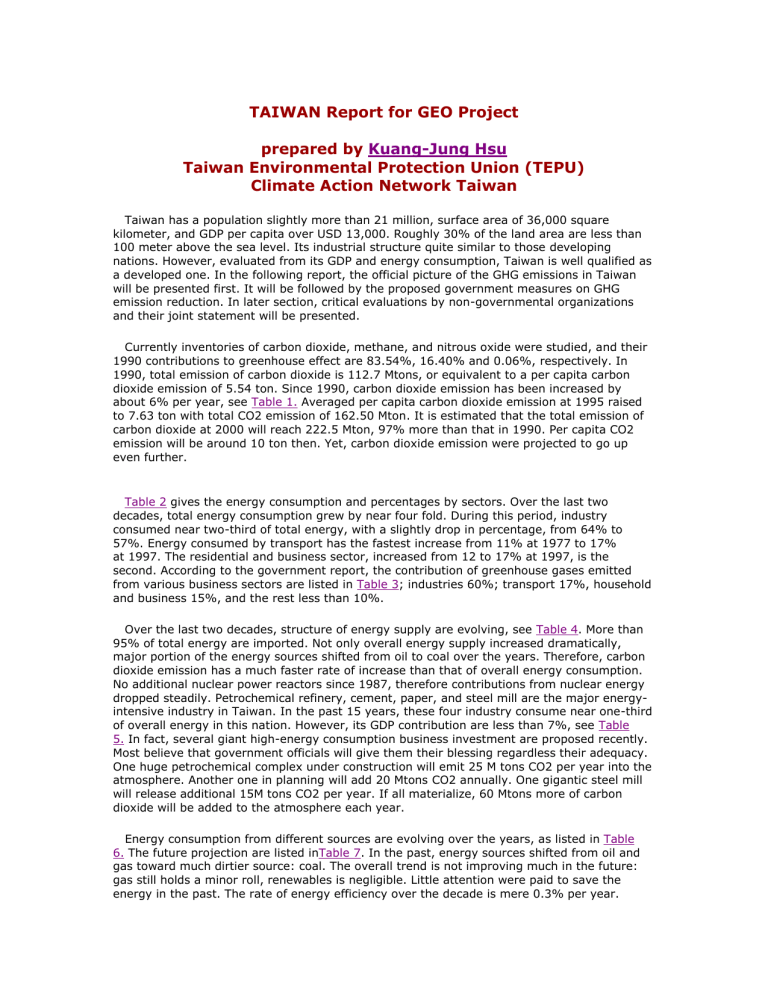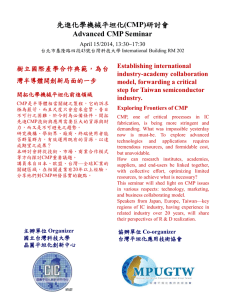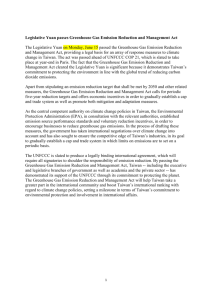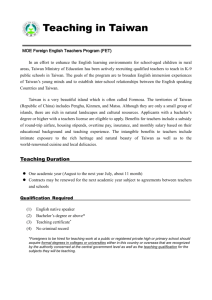in English - Helio International

TAIWAN Report for GEO Project prepared by Kuang-Jung Hsu
Taiwan Environmental Protection Union (TEPU)
Climate Action Network Taiwan
Taiwan has a population slightly more than 21 million, surface area of 36,000 square kilometer, and GDP per capita over USD 13,000. Roughly 30% of the land area are less than
100 meter above the sea level. Its industrial structure quite similar to those developing nations. However, evaluated from its GDP and energy consumption, Taiwan is well qualified as a developed one. In the following report, the official picture of the GHG emissions in Taiwan will be presented first. It will be followed by the proposed government measures on GHG emission reduction. In later section, critical evaluations by non-governmental organizations and their joint statement will be presented.
Currently inventories of carbon dioxide, methane, and nitrous oxide were studied, and their
1990 contributions to greenhouse effect are 83.54%, 16.40% and 0.06%, respectively. In
1990, total emission of carbon dioxide is 112.7 Mtons, or equivalent to a per capita carbon dioxide emission of 5.54 ton. Since 1990, carbon dioxide emission has been increased by about 6% per year, see Table 1.
Averaged per capita carbon dioxide emission at 1995 raised to 7.63 ton with total CO2 emission of 162.50 Mton. It is estimated that the total emission of carbon dioxide at 2000 will reach 222.5 Mton, 97% more than that in 1990. Per capita CO2 emission will be around 10 ton then. Yet, carbon dioxide emission were projected to go up even further.
Table 2 gives the energy consumption and percentages by sectors. Over the last two decades, total energy consumption grew by near four fold. During this period, industry consumed near two-third of total energy, with a slightly drop in percentage, from 64% to
57%. Energy consumed by transport has the fastest increase from 11% at 1977 to 17% at 1997. The residential and business sector, increased from 12 to 17% at 1997, is the second. According to the government report, the contribution of greenhouse gases emitted from various business sectors are listed in Table 3 ; industries 60%; transport 17%, household and business 15%, and the rest less than 10%.
Over the last two decades, structure of energy supply are evolving, see Table 4 . More than
95% of total energy are imported. Not only overall energy supply increased dramatically, major portion of the energy sources shifted from oil to coal over the years. Therefore, carbon dioxide emission has a much faster rate of increase than that of overall energy consumption.
No additional nuclear power reactors since 1987, therefore contributions from nuclear energy dropped steadily. Petrochemical refinery, cement, paper, and steel mill are the major energyintensive industry in Taiwan. In the past 15 years, these four industry consume near one-third of overall energy in this nation. However, its GDP contribution are less than 7%, see Table
5.
In fact, several giant high-energy consumption business investment are proposed recently.
Most believe that government officials will give them their blessing regardless their adequacy.
One huge petrochemical complex under construction will emit 25 M tons CO2 per year into the atmosphere. Another one in planning will add 20 Mtons CO2 annually. One gigantic steel mill will release additional 15M tons CO2 per year. If all materialize, 60 Mtons more of carbon dioxide will be added to the atmosphere each year.
Energy consumption from different sources are evolving over the years, as listed in Table
6.
The future projection are listed in Table 7 . In the past, energy sources shifted from oil and gas toward much dirtier source: coal. The overall trend is not improving much in the future: gas still holds a minor roll, renewables is negligible. Little attention were paid to save the energy in the past. The rate of energy efficiency over the decade is mere 0.3% per year.
On May 26-27, 1998, government held a national energy forum in response to the outcome of the Kyoto meeting. Main conclusions emerged from government are:
1. Improve energy efficiency by 1.2% per year. 'This is hardly achievable.'- according to chair of Energy Committee, Department of Economics.
2. Remove tax barrier for natural gas. Increase the use of natural gas from 3.3 Mtons now to
16Mtons at 2020.
3. An investment of 10 billion NT dollars in 5 years on research related to energy saving and clean energy development.
4. Percentage of nuclear energy is fixed at 1998 level. However, with the government projection of energy consumption at 2020, 8 more nuclear reactors will be added by then.
5. Take year 2000 or per capita carbon dioxide mission of 10 tons as the emission base.
6. The target year is year 2020, and the goal is within 10% of the emission base, 9 to 11 tons
CO2 per capita.
Environmental non-governmental organizations are strongly opposed those measures, since only the last 3 statements are what will be the future focus. As situation stated earlier, it is hardly feasible now for Taiwan to cut CO2 emission back to the 1990 level by year 2000.
Taiwan Environmental Protection Union as well as other environmental NGOs believe, the real
'no regret' policy are:
1. No nuclear energy as the alternative for CO2 reduction.
2. Set up appropriate policy to encourage the development of low-energy consumption, lowpolluting industry.
3. More emphases on energy saving, clean or new energy source development, and improve energy efficiency.
4. Act now and act sincerely. Choosing year 2000 as the base year is not appropriate. Even we may not contribute to sizable amount CO2 reduction as some other nations, at least we should do our best as a member on the Earth.
In 1995, Prof. Wang of Economics Department, National Chung-Hsing University (also chair,
Taiwan Environmental Protection Union) did study in searching the possible CO2 reduction strategies. Wang applied the structural decomposition analysis to four different scenarios.
Targets set for these four scenarios are (a) back to 1990 level; (b) scenario a relax by 20%;
(c) scenario a relax by 50%; and (d) stabilize emission by 2000. By varying the percentages of the following two parameters: improve industry energy efficiency and alter the export, consumption structure, CO2 emission level by 2000 can be evaluated. Results indicated that stabilizing the total CO2 emission around 2000 can be achieved by slowing the CO2 emission rate from 6%, 5%, 4%,.... The decreasing of CO2 emission are results from the combination of: (1) increasing the industrial energy efficiency by 35% and (2) changing the consumption and export structures to shift the industrial structure toward more energy-efficient industrial.
Carbon tax and economic incentives should apply in order to persuade more people to live a more environmental friendly lives.
Maybe the most sensitive issue in UNFCCC negotiation is whether the non-Annex I countries should shoulder some responsibilities. Although Annex I countries are still the main source of
CO2 in the air, the non-Annex I countries are catching up fast. Therefore, participation of the non-Annex I nations are critical to stabilize the atmospheric green house gases. Since most believe that better environment protection will hurt the economy. It is not unreasonable for the developing nations to improve the living standard of their people before investing on protecting the environment. However, economic growth and environment protection can coexist if more considerations are introduced; the past experience from OECD countries set up a good example.
Taiwan has an awkward international status. She is not a member of the United Nations, therefore cannot participate UNFCCC negotiations. However, there are advantages to persuade or encourage the Taiwanese government to pursue the GHG control similar to those of the
Annex-I countries.
Both Taiwan and Singapore have good foundations both in economy and technology.
It would be much easier for these two countries to reduce GHG emission than most non-
Annex I countries. If Taiwan demonstrates the possibility that reduction of GHG emission and sustain economic growth, many countries soon will soon follow.
Kuang-Jung Hsu, Coordinator, Academic Committee, Taiwan Environmental Protection Union
(TEPU) member, Climate Action Network Taiwan also as Professor, Department of Atmospheric
Sciences, National Taiwan University, Taipei, Taiwan.
Taiwan Environmental Protection Union (TEPU) is the leading non-government environmental organization in Taiwan. Currently, it consists of eleven local chapters and an academic committee formed by professionals. Founded on 1st of November, 1987, all programs and activities promoted by TEPU are trying to protect the environment and for sustainable development.








